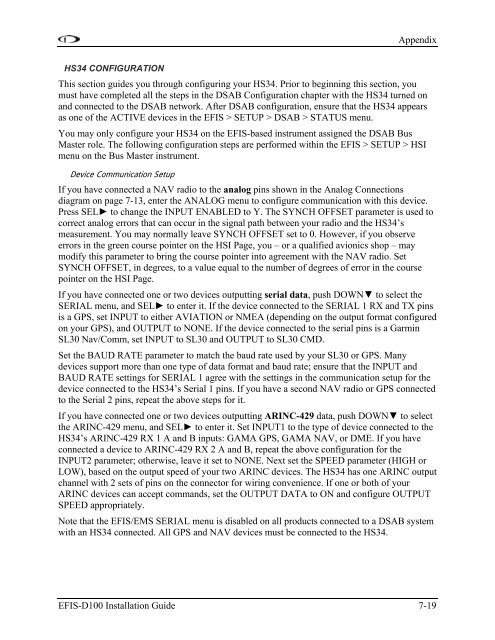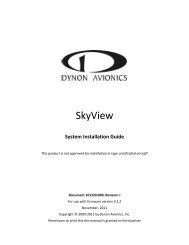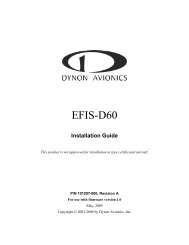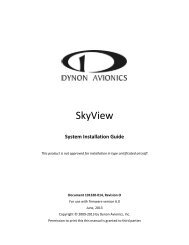EFIS-D100 Installation Guide - Dynon Avionics
EFIS-D100 Installation Guide - Dynon Avionics
EFIS-D100 Installation Guide - Dynon Avionics
Create successful ePaper yourself
Turn your PDF publications into a flip-book with our unique Google optimized e-Paper software.
Appendix<br />
HS34 CONFIGURATION<br />
This section guides you through configuring your HS34. Prior to beginning this section, you<br />
must have completed all the steps in the DSAB Configuration chapter with the HS34 turned on<br />
and connected to the DSAB network. After DSAB configuration, ensure that the HS34 appears<br />
as one of the ACTIVE devices in the <strong>EFIS</strong> > SETUP > DSAB > STATUS menu.<br />
You may only configure your HS34 on the <strong>EFIS</strong>-based instrument assigned the DSAB Bus<br />
Master role. The following configuration steps are performed within the <strong>EFIS</strong> > SETUP > HSI<br />
menu on the Bus Master instrument.<br />
Device Communication Setup<br />
If you have connected a NAV radio to the analog pins shown in the Analog Connections<br />
diagram on page 7-13, enter the ANALOG menu to configure communication with this device.<br />
Press SEL► to change the INPUT ENABLED to Y. The SYNCH OFFSET parameter is used to<br />
correct analog errors that can occur in the signal path between your radio and the HS34’s<br />
measurement. You may normally leave SYNCH OFFSET set to 0. However, if you observe<br />
errors in the green course pointer on the HSI Page, you – or a qualified avionics shop – may<br />
modify this parameter to bring the course pointer into agreement with the NAV radio. Set<br />
SYNCH OFFSET, in degrees, to a value equal to the number of degrees of error in the course<br />
pointer on the HSI Page.<br />
If you have connected one or two devices outputting serial data, push DOWN▼ to select the<br />
SERIAL menu, and SEL► to enter it. If the device connected to the SERIAL 1 RX and TX pins<br />
is a GPS, set INPUT to either AVIATION or NMEA (depending on the output format configured<br />
on your GPS), and OUTPUT to NONE. If the device connected to the serial pins is a Garmin<br />
SL30 Nav/Comm, set INPUT to SL30 and OUTPUT to SL30 CMD.<br />
Set the BAUD RATE parameter to match the baud rate used by your SL30 or GPS. Many<br />
devices support more than one type of data format and baud rate; ensure that the INPUT and<br />
BAUD RATE settings for SERIAL 1 agree with the settings in the communication setup for the<br />
device connected to the HS34’s Serial 1 pins. If you have a second NAV radio or GPS connected<br />
to the Serial 2 pins, repeat the above steps for it.<br />
If you have connected one or two devices outputting ARINC-429 data, push DOWN▼ to select<br />
the ARINC-429 menu, and SEL► to enter it. Set INPUT1<br />
to the type of device connected to the<br />
HS34’s ARINC-429 RX 1 A and B inputs: GAMA GPS,<br />
GAMA NAV, or DME. If you have<br />
connected a device to ARINC-429 RX 2 A and B, repeat the above configuration for the<br />
INPUT2 parameter; otherwise, leave it set to NONE. Next set the SPEED parameter (HIGH or<br />
LOW), based on the output speed of your two ARINC devices. The HS34 has one ARINC output<br />
channel with 2 sets of pins on the connector for wiring convenience. If one or both of your<br />
ARINC devices can accept commands, set the OUTPUT<br />
DATA to ON and configure OUTPUT<br />
SPEED appropriately.<br />
Note that the <strong>EFIS</strong>/EMS SERIAL menu is disabled on all products connected to a DSAB system<br />
with an HS34 connected. All GPS and NAV devices must<br />
be connected to the HS34.<br />
<strong>EFIS</strong>-<strong>D100</strong> <strong>Installation</strong> <strong>Guide</strong> 7-19
















